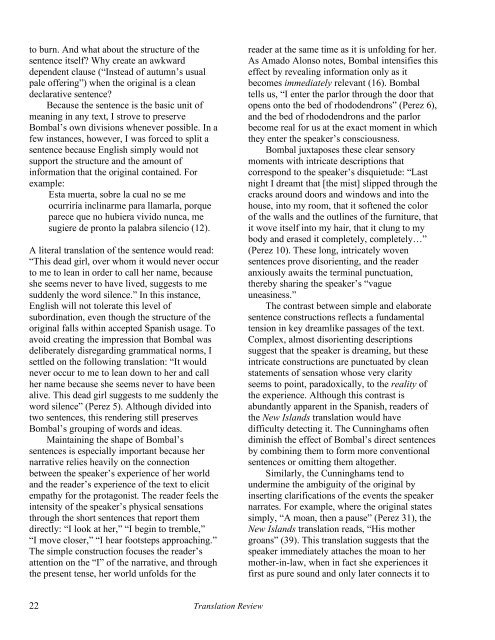table of contents - The University of Texas at Dallas
table of contents - The University of Texas at Dallas
table of contents - The University of Texas at Dallas
You also want an ePaper? Increase the reach of your titles
YUMPU automatically turns print PDFs into web optimized ePapers that Google loves.
to burn. And wh<strong>at</strong> about the structure <strong>of</strong> the<br />
sentence itself? Why cre<strong>at</strong>e an awkward<br />
dependent clause (“Instead <strong>of</strong> autumn’s usual<br />
pale <strong>of</strong>fering”) when the original is a clean<br />
declar<strong>at</strong>ive sentence?<br />
Because the sentence is the basic unit <strong>of</strong><br />
meaning in any text, I strove to preserve<br />
Bombal’s own divisions whenever possible. In a<br />
few instances, however, I was forced to split a<br />
sentence because English simply would not<br />
support the structure and the amount <strong>of</strong><br />
inform<strong>at</strong>ion th<strong>at</strong> the original contained. For<br />
example:<br />
Esta muerta, sobre la cual no se me<br />
ocurriría inclinarme para llamarla, porque<br />
parece que no hubiera vivido nunca, me<br />
sugiere de pronto la palabra silencio (12).<br />
A literal transl<strong>at</strong>ion <strong>of</strong> the sentence would read:<br />
“This dead girl, over whom it would never occur<br />
to me to lean in order to call her name, because<br />
she seems never to have lived, suggests to me<br />
suddenly the word silence.” In this instance,<br />
English will not toler<strong>at</strong>e this level <strong>of</strong><br />
subordin<strong>at</strong>ion, even though the structure <strong>of</strong> the<br />
original falls within accepted Spanish usage. To<br />
avoid cre<strong>at</strong>ing the impression th<strong>at</strong> Bombal was<br />
deliber<strong>at</strong>ely disregarding gramm<strong>at</strong>ical norms, I<br />
settled on the following transl<strong>at</strong>ion: “It would<br />
never occur to me to lean down to her and call<br />
her name because she seems never to have been<br />
alive. This dead girl suggests to me suddenly the<br />
word silence” (Perez 5). Although divided into<br />
two sentences, this rendering still preserves<br />
Bombal’s grouping <strong>of</strong> words and ideas.<br />
Maintaining the shape <strong>of</strong> Bombal’s<br />
sentences is especially important because her<br />
narr<strong>at</strong>ive relies heavily on the connection<br />
between the speaker’s experience <strong>of</strong> her world<br />
and the reader’s experience <strong>of</strong> the text to elicit<br />
emp<strong>at</strong>hy for the protagonist. <strong>The</strong> reader feels the<br />
intensity <strong>of</strong> the speaker’s physical sens<strong>at</strong>ions<br />
through the short sentences th<strong>at</strong> report them<br />
directly: “I look <strong>at</strong> her,” “I begin to tremble,”<br />
“I move closer,” “I hear footsteps approaching.”<br />
<strong>The</strong> simple construction focuses the reader’s<br />
<strong>at</strong>tention on the “I” <strong>of</strong> the narr<strong>at</strong>ive, and through<br />
the present tense, her world unfolds for the<br />
22 Transl<strong>at</strong>ion Review<br />
reader <strong>at</strong> the same time as it is unfolding for her.<br />
As Amado Alonso notes, Bombal intensifies this<br />
effect by revealing inform<strong>at</strong>ion only as it<br />
becomes immedi<strong>at</strong>ely relevant (16). Bombal<br />
tells us, “I enter the parlor through the door th<strong>at</strong><br />
opens onto the bed <strong>of</strong> rhododendrons” (Perez 6),<br />
and the bed <strong>of</strong> rhododendrons and the parlor<br />
become real for us <strong>at</strong> the exact moment in which<br />
they enter the speaker’s consciousness.<br />
Bombal juxtaposes these clear sensory<br />
moments with intric<strong>at</strong>e descriptions th<strong>at</strong><br />
correspond to the speaker’s disquietude: “Last<br />
night I dreamt th<strong>at</strong> [the mist] slipped through the<br />
cracks around doors and windows and into the<br />
house, into my room, th<strong>at</strong> it s<strong>of</strong>tened the color<br />
<strong>of</strong> the walls and the outlines <strong>of</strong> the furniture, th<strong>at</strong><br />
it wove itself into my hair, th<strong>at</strong> it clung to my<br />
body and erased it completely, completely…”<br />
(Perez 10). <strong>The</strong>se long, intric<strong>at</strong>ely woven<br />
sentences prove disorienting, and the reader<br />
anxiously awaits the terminal punctu<strong>at</strong>ion,<br />
thereby sharing the speaker’s “vague<br />
uneasiness.”<br />
<strong>The</strong> contrast between simple and elabor<strong>at</strong>e<br />
sentence constructions reflects a fundamental<br />
tension in key dreamlike passages <strong>of</strong> the text.<br />
Complex, almost disorienting descriptions<br />
suggest th<strong>at</strong> the speaker is dreaming, but these<br />
intric<strong>at</strong>e constructions are punctu<strong>at</strong>ed by clean<br />
st<strong>at</strong>ements <strong>of</strong> sens<strong>at</strong>ion whose very clarity<br />
seems to point, paradoxically, to the reality <strong>of</strong><br />
the experience. Although this contrast is<br />
abundantly apparent in the Spanish, readers <strong>of</strong><br />
the New Islands transl<strong>at</strong>ion would have<br />
difficulty detecting it. <strong>The</strong> Cunninghams <strong>of</strong>ten<br />
diminish the effect <strong>of</strong> Bombal’s direct sentences<br />
by combining them to form more conventional<br />
sentences or omitting them altogether.<br />
Similarly, the Cunninghams tend to<br />
undermine the ambiguity <strong>of</strong> the original by<br />
inserting clarific<strong>at</strong>ions <strong>of</strong> the events the speaker<br />
narr<strong>at</strong>es. For example, where the original st<strong>at</strong>es<br />
simply, “A moan, then a pause” (Perez 31), the<br />
New Islands transl<strong>at</strong>ion reads, “His mother<br />
groans” (39). This transl<strong>at</strong>ion suggests th<strong>at</strong> the<br />
speaker immedi<strong>at</strong>ely <strong>at</strong>taches the moan to her<br />
mother-in-law, when in fact she experiences it<br />
first as pure sound and only l<strong>at</strong>er connects it to

















